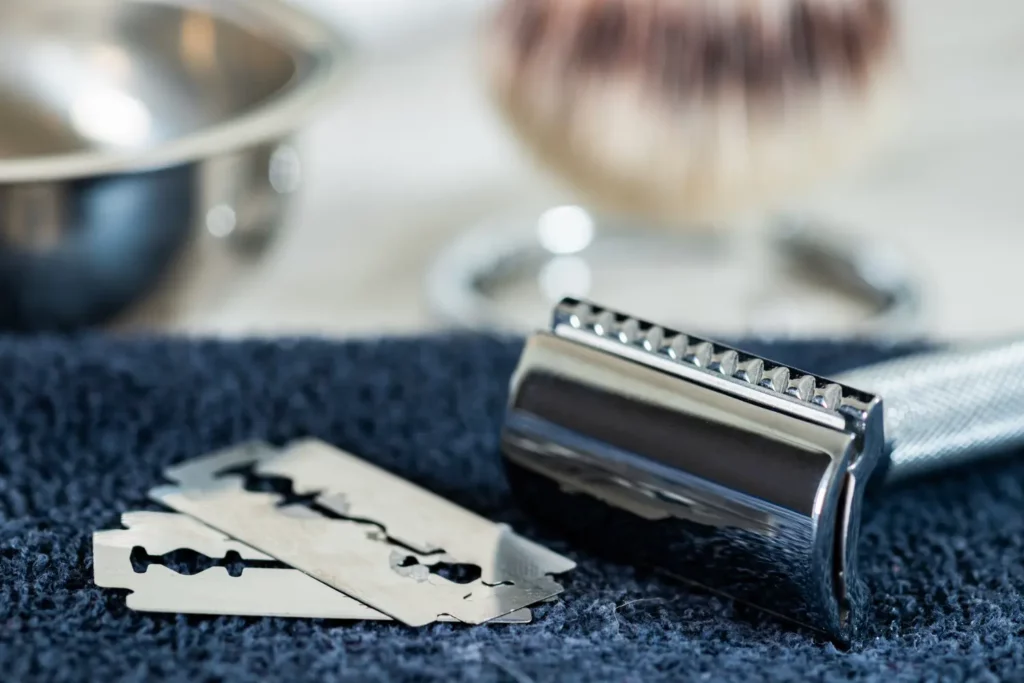Safety razors have gained popularity in recent years as many people switch from expensive cartridges and disposable razors to this more sustainable, traditional method of shaving.
Although typically associated with wet shaving, it’s possible to dry shave with a safety razor effectively. While not typically recommended due to the increased risk of irritation and nicks, dry shaving with a safety razor can still provide a close shave when done properly.
We’ll go over all the key steps and techniques to ensure a smooth and comfortable dry shave experience using a safety razor.
| Step | Dry Shaving Technique |
|---|---|
| 1 | Choose a fresh blade |
| 2 | Don’t hold skin too taut |
| 3 | Apply little to no pressure |
| 4 | Go with the grain |
| 5 | Use short, overlapping strokes |
Step-by-Step Guide: Dry Shaving with a Safety Razor
1. Choose a Fresh Blade for Your Safety Razor

Using a sharp, fresh blade is essential for a comfortable and efficient dry shave. Dull or rusted blades can cause irritation, ingrown hairs, and an uneven shave. Additionally, a dull or worn blade exponentially increases the risk of cuts and nicks.
Make sure to replace the blade after every 3-5 shaves or as soon as you notice any decline in performance or smoothness.
For dry shaving, we recommend Feather or Kai double-edge razor blades, as they are known by wet shaving enthusiasts for their sharpness and precision.
2. Don’t Hold Your Skin Too Taut
According to a dermatology study by the American Academy of Dermatology, holding the skin taut is discouraged when dry shaving with a safety razor.
Tightening the skin may increase the chances of cuts and irritation due to razor burn and irritated skin because the blade will be cutting too close. Instead, hold the skin gently and naturally while shaving, allowing the razor to glide smoothly over the contours of your face.
3. Apply Little to No Pressure for a Gentle Shave
With the lack of water, folks may try to compensate by applying too much pressure. However, when dry shaving with a safety razor, it’s essential to let the weight of the razor do the work.
An article by Art of Manliness suggests holding the handle with only two fingers to ensure minimal pressure is applied.
In addition, make sure that the razor is held at the optimal angle of 30 to 45 degrees to your skin to allow for the closest and most comfortable shave. Using gentle strokes and maintaining the correct angle will help prevent nicks, cuts, and irritation.
4. Go With the Grain
No matter the shaving method, it’s always advised to shave in the direction of hair growth, also known as “with the grain.” This will drastically increase comfort and reduce the chances of irritation, ingrown hairs, and razor bumps.
When dry shaving, this becomes even more critical, as there is no lubrication to provide an extra layer of protection against such issues.
5. Use Short, Overlapping Strokes for a Consistent Shave
When dry shaving, use short, overlapping strokes rather than long, sweeping motions. This method helps maintain the blade’s optimal angle and lets you easily navigate the contours of your face. It also prevents clogged blades while ensuring a closer shave without needing to apply additional pressure.
Try rinsing off the razor frequently with cold water to keep the blades clean and free of accumulated hair and debris. This will not only prevent clogging but also maintain the sharpness and efficiency of the blade, resulting in a smoother and more comfortable shave.
However, if water isn’t available, you can use a dry cloth or a small brush to clean the razor between strokes. Just make sure to be gentle and not damage the blade or its alignment.
Essential Tips for Better Results in Dry Shaving with a Safety Razor
Here are a few additional tips to keep in mind when dry shaving with a safety razor for better results and an overall comfortable experience:
- Prepare your facial hair: Before you begin dry shaving, ensure that your beard or facial hair is clean and free of dirt, oil, and dead skin cells. Use a gentle cleanser, and then pat your face dry with a clean towel. This process will also open your pores, allowing for a smoother shave.
- Look after your safety razor: Proper cleaning and maintenance of your double-edged safety razor will extend its lifespan and ensure better shaves. Disassemble your razor at least once a week and clean the components with warm soapy water to remove any build-up of shaving soap or whiskers.
- Soothing aftershave: Whether using a moisturizer, aloe vera, or an aftershave balm, it’s essential to apply a soothing product to your skin after dry shaving to reduce irritation and soothe sensitive skin.
- Practice makes perfect: Consistently shaving with a safety razor will improve your technique, helping you achieve better shaves in the long run. Be patient, as the learning curve can be steep, especially when transitioning from electric shavers or multi-blade cartridge razors.